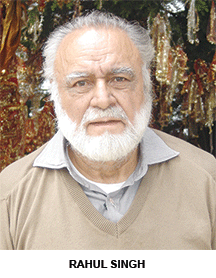Social engineering lesson from America
 Rahul Singh is the former editor of Reader’s Digest, Indian Express and Khaleej Times
Rahul Singh is the former editor of Reader’s Digest, Indian Express and Khaleej Times
Considerable attention in both the print and electronic media has lately been focused on the poor and vulnerable status of Indian girls and women, following the gang rape and subsequent death of a 23-year-old physiotherapy intern in Delhi on December 29. Understandable outrage has been stridently expressed about this emotionally-churning incident, even though blinkered politicians like RSS chief Mohan Bhagwat have dismissed it as a phenomenon of ‘India’, rather than ‘Bharat’, where Hindu moralistic values prevail (never mind that facts on the ground are entirely contrary to his assertion).
However, there is another deep-rooted social malaise that needs more urgent addressal. It is the centuries-old but still deeply-rooted malevolent discrimination against people of the scheduled castes and scheduled tribes (SCs and STs) collectively known as Dalits (“the oppressed”). Despite sustained attempts of Hindu reformers like Raja Ram Mohun Roy and Mahatma Gandhi and well-meaning affirmative action measures, the socio-economic condition of the nation’s Dalits who constitute an estimated 25 percent of the population, is pathetic.
Proof of this is provided by a four-month-long survey conducted by the Indian Institute of Dalit Studies (IIDS) on the implementation of the mid-day meal scheme in government primary schools countrywide. The survey covered 122 schools across the seven most populous states of the country. Its conclusions are revealing and shocking.
According to Nidhi Sabharwal and Dilip Dawarkar, the director and associate fellow of IIDS respectively, writing in the Indian Express (December 11, 2012), a substantial percentage of Dalit students are subjected to various forms of discrimination. They are given less food and served separately from upper caste children; they have to carry their own plates from home so they don’t get mixed up with those used by others, and they are not allowed to serve food. The report also recounts mortifying instances of how the food for Dalit children is dropped from a distance as if dogs are being served.
Such shameless prejudice is bad enough, but its consequences are worse. Over half the parents of Dalit children surveyed said that humiliating in-school discrimination discourages their children from attending classes or adversely affects academic performance. The irony is that the prime objective of the mid-day meal scheme which is to improve school attendance and reduce drop-out rates has been achieved only among higher caste students. But prolonged discrimination has had the reverse impact on Dalit school children. A Unicef study (2006) confirms that drop-out percentages among Dalit students in primary schools are an unacceptably high 44 percent, far higher than that of upper-caste students with the difference widening since then.
These are dismaying statistics and should set alarm bells ringing in the Union human resource development ministry. According to the 2001 census, the population of SCs aggregates 167 million. In addition, 70 million tribals (STs) face much the same discrimination as SCs, with their education standards diving even lower. Together, SCs and STs constitute almost a quarter of India’s population, of whom about 80 percent live below the poverty line, and own a mere 5 percent of the country’s resources. Many of them are bonded labourers and over 60 percent of them are illiterate (compared to 35 percent illiteracy for the country as a whole). Regrettably, sustained discrimination against the Dalit community including children isn’t practiced only by caste Hindus. Even converts to Islam, Christianity and Sikhism, which are supposedly casteless and egalitarian creeds, practice a not-so-subtle system of casteism.
Clearly, much needs to be done to make Indian society more equitable and less discriminatory. Laws making the practice of untouchability illegal have existed for decades, but aren’t adequately implemented. Reservation for Dalits in education institutions and government jobs have certainly made a difference, even though the provisions have often been misused for political purposes with Dalits used as vote banks. The real challenge lies in changing mindsets and removing prejudices based on the pernicious and feudalistic caste system. Rural ‘Bharat’, rather than urban India, is where the battle for hearts and minds has to be fought.
For the most part of the 20th century, the US was confronted with a similar, and arguably stiffer challenge regarding its black (the politically acceptable term is African-American) population. But the challenge was overcome through a mixture of affirmative action measures and steady erasure of prejudiced attitudes, culminating in the election and re-election last November of Barack Obama as the country’s first African-American President. We need to learn from the American experience in social engineering. Since education is the key to self-reliance, we need to urgently improve academic standards, especially in primary education. Better education invariably translates into empowerment, and therefore into more inclusive economic growth. It also leads to greater tolerance and better understanding among different communities. This should be India’s path.
Other articles by Rahul Singh:





 Rahul Singh is the former editor of Reader’s Digest, Indian Express and Khaleej Times
Rahul Singh is the former editor of Reader’s Digest, Indian Express and Khaleej Times









Add comment